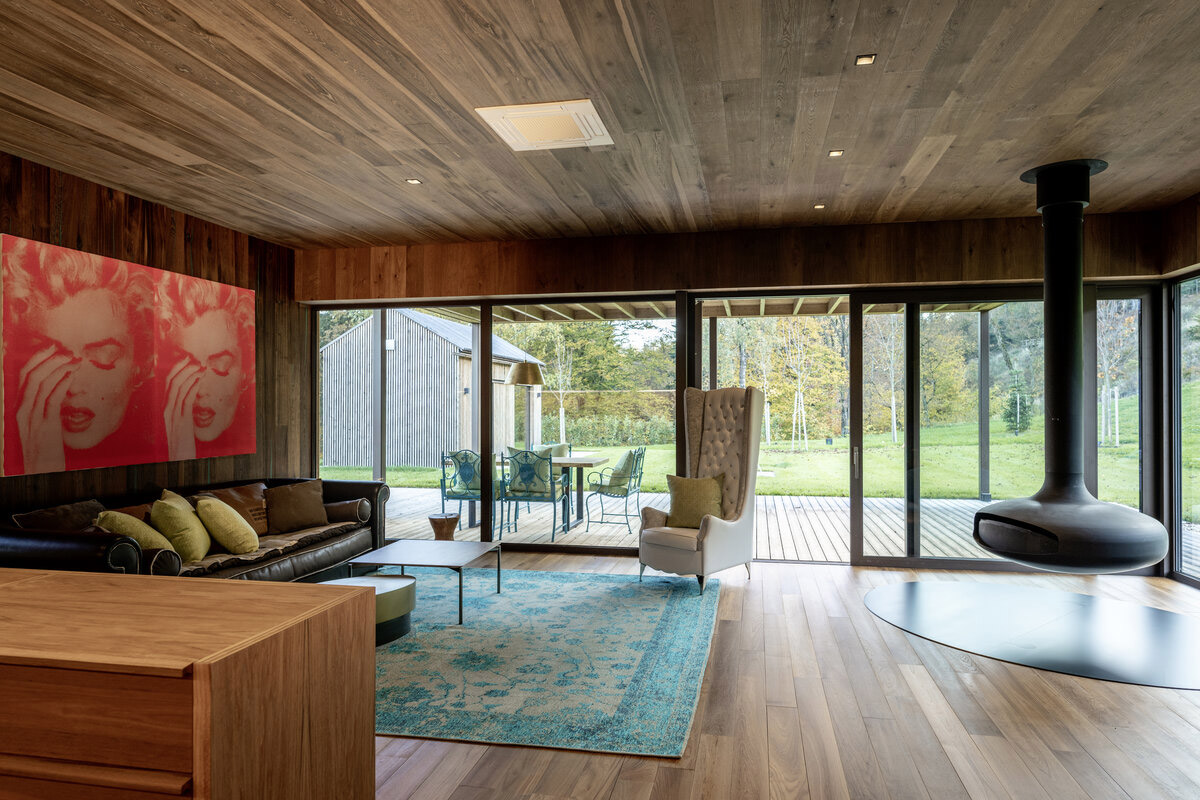mafi Walls & Ceilings
Coziness, warmth, cohesion.
Using mafi natural wood flooring to clad walls and ceilings adds warmth and comfort to any space while maintaining a unified design theme. This technique lets you highlight specific sections using the same material as your wood flooring.
BOISERIE
BOISERIE Linear:
The milling cuts through the top layer, exposing the black middle layer for a striking contrast. Further longitudinal milling adds subtle grooves across the planks, enhancing their room-wide impact. The sleek, linear design works perfectly to extend the appearance of room heights and highlight specific interior spaces.
BOISERIE Reserve:
Partially inspired by wine labeling, the “Reserve” variant features a subdued design. Its subtle milling deepens the top layer without reaching the middle layer, creating an interaction between the sophisticated top layer and the second layer, characterized by fine grooves.
mafi Flex
The innovative approach of using flexible floorboards to clad walls marks a bold architectural move. With the latest FLEX processing technology, floorboards are bent to form a seamless unity between the flooring and the wooden walls.
This method allows even complex floor plans and intricately shaped walls to be visually enhanced and showcased attractively through curved cladding. A curved wooden wall is a striking design feature in an office, a restaurant, or a private home.
Domino
Crafted from specially heat-treated spruce, free from chemical additives, our mafi Domino materials are assembled into compact, ready-to-install elements comprising 40 x 40 mm end-grain blocks. These elements are securely fastened together on a parquet net.
Though isolated stress cracks and expansion gaps may occur, typically due to climatic changes, these imperfections have no bearing on the floor’s functionality, including its strength and stress-bearing capabilities.
mafi Domino is exclusively available in unfinished form, allowing for the application of mafi natural oils to achieve the desired final appearance.
Swiss Stone Pine
The Swiss stone pine finds its natural habitat in the high Alpine regions of the Alps, flourishing at elevations between 1,500 and 2,200 meters. It excels in cold, harsh climates, enduring temperature variations and persisting in soil frozen for extended periods. Despite these demanding conditions, it can achieve remarkable longevity, often living up to 1,000 years or beyond.
Pine contributes to our overall well-being: Natural, oiled pine wood provides not only a delightful aroma but also fosters an enhanced sense of wellness, improves circulation, promotes harmony, and reduces sensitivity to changes in weather. Additionally, pine wood can neutralize unpleasant odors.
Research conducted at the Institute of Genetics and General Biology at the University of Salzburg has demonstrated the significant antibacterial properties of pine wood. Consequently, food items stored in pine containers are exceptionally well-preserved.
mafi Walls & Ceilings Q&A:
What advantages does using wood on walls and ceilings provide?
Untreated natural wood seamlessly complements human living spaces while sharing its healthful attributes. In this context, naturalness entails abstaining from sealing the wood’s surface or pores, thereby enabling moisture exchange to continue.
The optimal method involves treating the wood with natural oil allowing it to air dry. This allows the oil to penetrate deep within the wood, safeguarding it from within rather than forming a plasticized layer on the surface, as is familiar with most other finishing methods.
Natural wood boasts superior hygiene benefits– it kills bacteria and germs or prevents them from adhering to the surface altogether. Regular soap care further reinforces this hygiene effect.
Does wood add acoustical value when installed on walls and ceilings?
For centuries, wood has reigned supreme as the go-to material for exceptional acoustic performance. Its unique properties enable it to produce sound through direct striking while also effectively amplifying or absorbing sound waves. This makes wood an unparalleled choice not only for musical instruments but also for a myriad of acoustic applications, including architectural ones.
In spaces like auditoriums and performance venues—concert halls, classrooms, and lecture theatres—wood often takes center stage, surpassing alternatives like steel, concrete, and glass. Its innate ability to create immersive acoustic environments for both performers and audiences alike is unmatched.
Wood’s versatility extends beyond its acoustic qualities; it also serves as a valuable material for acoustic treatments and sound deflection. Whether as acoustic panels adorning ceilings or walls, wood adds a touch of aesthetic warmth while enhancing sound quality.
Can flooring be used on my walls and ceilings?
Join the Email List
Stay up to date on our latest news & events
